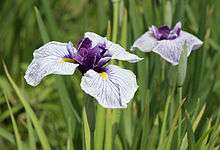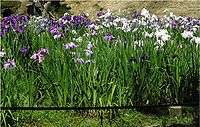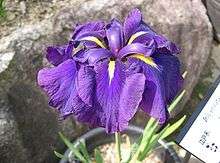Iris ensata
| Japanese iris | |
|---|---|
 | |
| Iris ensata (Edo-nishiki) | |
| Scientific classification | |
| Kingdom: | Plantae |
| (unranked): | Angiosperms |
| (unranked): | Monocots |
| Order: | Asparagales |
| Family: | Iridaceae |
| Genus: | Iris |
| Subgenus: | Limniris |
| Series: | Iris series Laevigatae |
| Species: | I. ensata |
| Binomial name | |
| Iris ensata Thunb. | |
| Synonyms | |
|
Iris kaempferi Siebold ex Lem. | |
Iris ensata (Japanese iris, Japanese: hanashōbu) is a species of Iris native to Japan, China, Korea and Russia, and widely cultivated as an ornamental plant. Japanese iris may also refer to other culturally significant species of Iris native to Japan.
The bluish purple color of the flowers of the Japanese garden iris is an example of the copigmentation phenomenon.[1]


Cultivation
Iris ensata is extensively grown as an ornamental plant in gardens and parks throughout the temperate zones of the world.
The Hanashōbu (ハナショウブ, 花菖蒲, Iris ensata var. ensata) grows in the wet land and is the most extensively cultivated variety in Japanese gardens. According to the place where it was cultivated, it is classified into the Edo (Tokyo), Higo (Kumamoto Prefecture), Ise (Mie Prefecture), American (U.S.), and other series.
Several cultivars have been selected, of which 'Rose Queen'[2] and 'Variegata'[3] have gained the Royal Horticultural Society's Award of Garden Merit.
References
- ↑ Anthocyanin-flavone copigmentation in bluish purple flowers of Japanese garden iris (Iris ensata Thunb.) T. Yabuya, M. Nakamura, T. Iwashina, M. Yamaguchi and T. Takehara, EUPHYTICA, Volume 98, Number 3, 163-167, doi:10.1023/A:1003152813333
- ↑ "RHS Plant Selector - Iris ensata 'Rose Queen'". Royal Horticultural Society. Retrieved 2013-05-20.
- ↑ "RHS Plant Selector - Iris ensata 'Variegata'". Royal Horticultural Society. Retrieved 2013-05-20.
External links
 Media related to Iris ensata at Wikimedia Commons
Media related to Iris ensata at Wikimedia Commons- Hanashobu Park in Sawara, Japan
 Data related to Iris ensata at Wikispecies
Data related to Iris ensata at Wikispecies